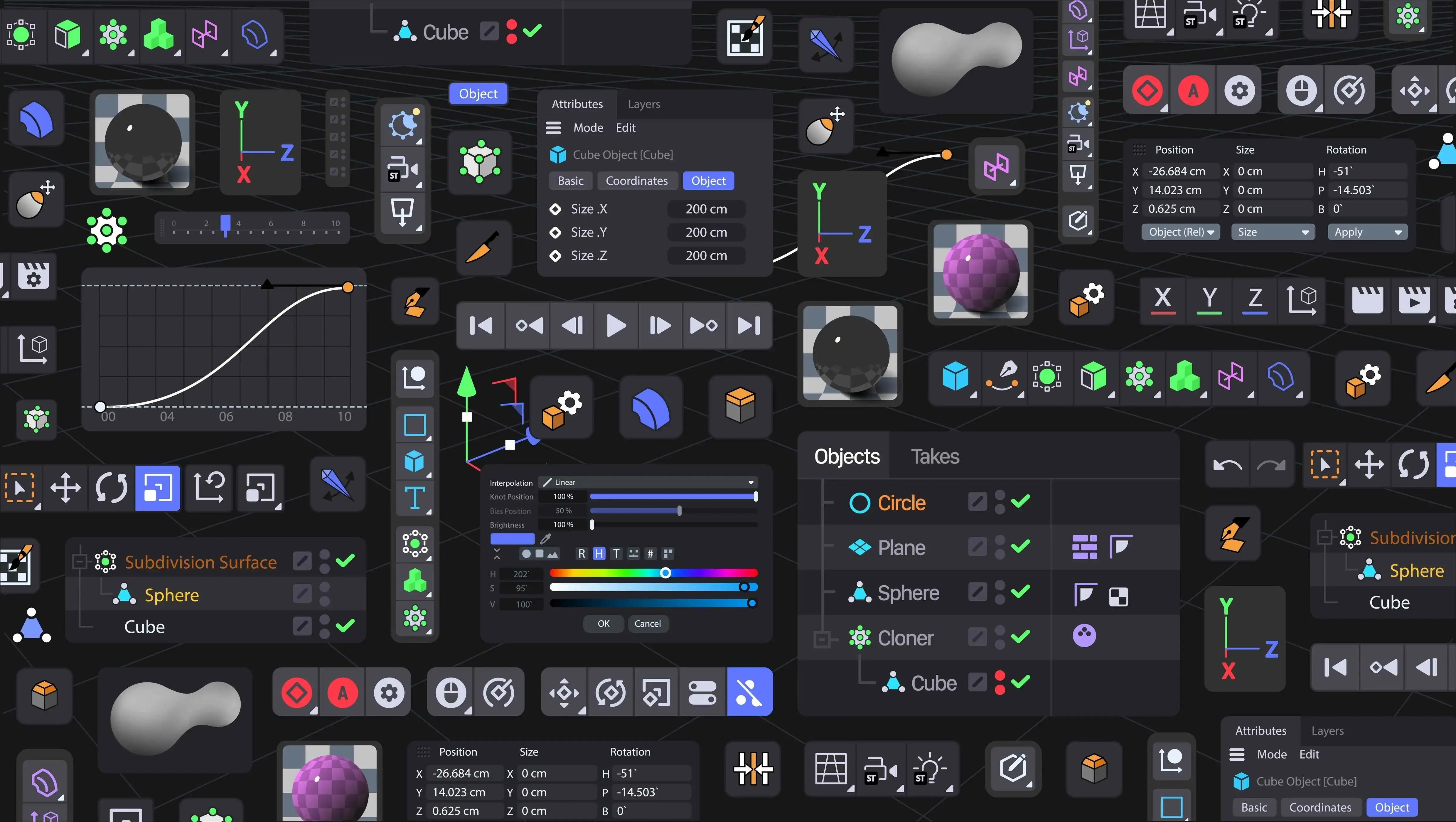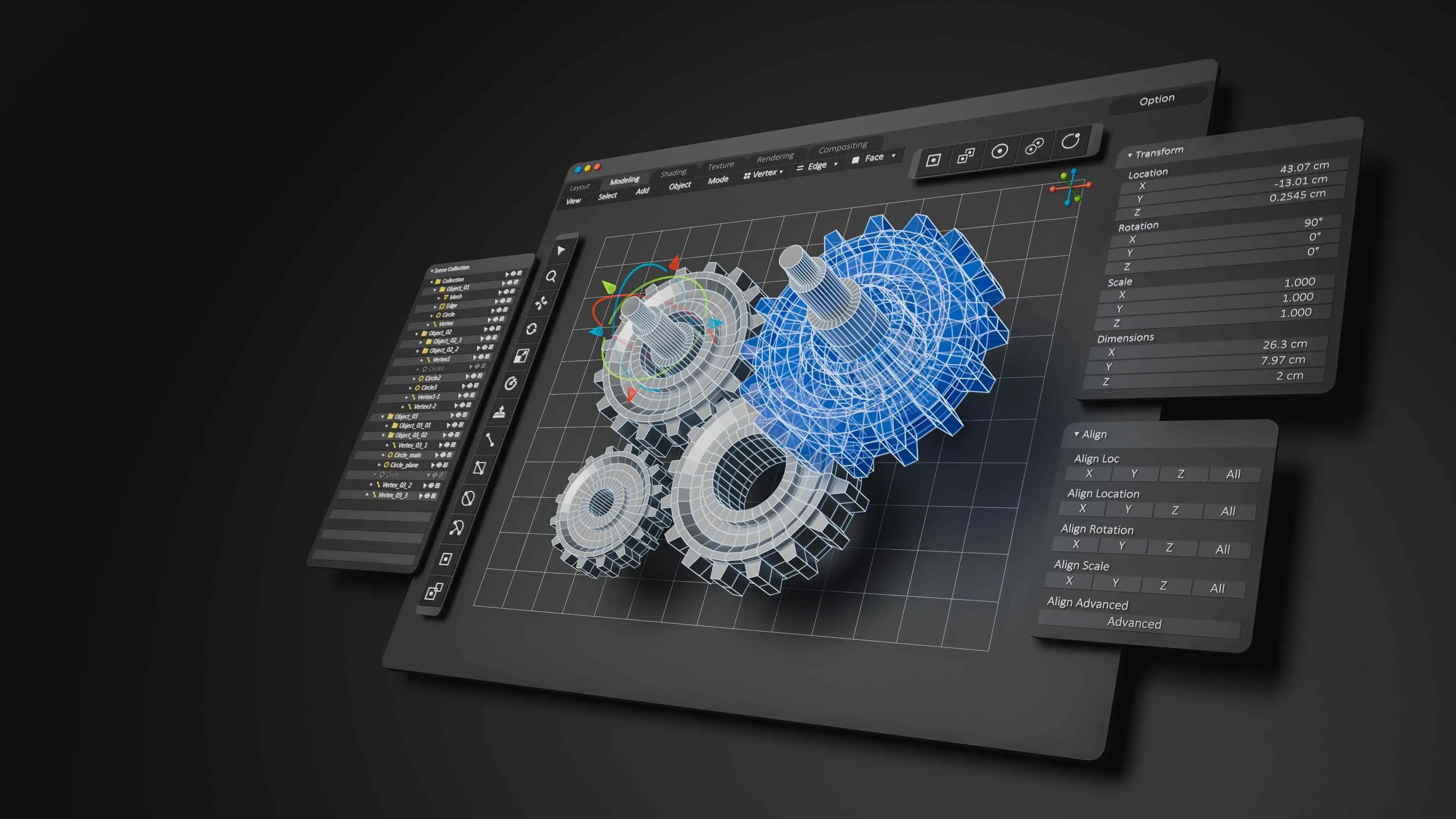Gaming. Architecture. Virtual reality. These industries aren’t just growing—they’re being reshaped by 3D modeling. What used to be a niche skill is now the engine behind immersive worlds, digital showrooms, and next-gen experiences.
Platforms like TurboSquid, CGTrader, and Sketchfab are more than marketplaces—they're launchpads. Whether you're an indie artist or building for global studios, these sites let you turn your creations into income and your portfolio into a business.
Looking to build your own platform? Use hosting to create a personalized storefront and sell your 3D assets directly to your audience. Need help driving traffic? Check out these tips on increasing visibility through social media.
The demand is real. The audience is massive. And your models could be exactly what someone needs right now.
TL;DR:
3D modeling generates income through marketplaces (TurboSquid, CGTrader, Sketchfab), direct sales via personal websites, licensing, 3D printing, and educational content.
Key industries driving demand include gaming, architecture, AR/VR, product design, and e-commerce. Critical trends shaping the market are AI-driven modeling, real-time rendering, stylized assets, cloud collaboration, and cross-platform formats like glTF.
Success depends on mastering modeling tools, protecting intellectual property, pricing strategically, and promoting work through SEO and social media.
Key Trends Shaping the 3D Modeling Market
The 3D modeling space is evolving fast. Here are the top trends shaping where it’s headed next:
Real-Time and Ray-Traced Rendering
Real-time ray tracing brings cinematic lighting, shadows, and reflections to games, architecture, and simulations—now accessible even to solo creators.
Non-Photorealistic Rendering (NPR)
Stylized visuals are gaining traction, especially in animation and indie games. To sell NPR assets directly, consider setting up a site with shared hosting.
Generative Design
AI-driven tools are enabling the creation of complex, organic shapes—ideal for architecture, product design, and experimental workflows. Learn more about AI design tools.
3D Modeling for AR/VR Experiences
As demand for immersive content grows, creators are optimizing assets for real-time use in AR and VR. Promote your models with social media strategies.
Cross-Platform and Web-Based 3D
Lightweight formats like glTF make 3D assets usable across browsers, mobile, and AR. If you're serving clients, reseller hosting can help deliver assets efficiently.
Marketplace Integration and Direct Sales
Creators are blending marketplace reach with direct sales to grow revenue. Use WordPress hosting to launch your own store and own your audience.
Stay informed, stay flexible, and you’ll stay ahead.
Industries Driving Demand for 3D Models
Gaming
The gaming industry relies on high-quality 3D models for characters, environments, props, and animations to build immersive, interactive experiences across consoles, mobile, and VR platforms.Architecture and Real Estate
3D models are essential for visualizing buildings, interiors, and landscapes, helping architects and real estate professionals present concepts to clients and investors.Virtual and Augmented Reality
AR and VR applications depend on optimized 3D assets to create immersive worlds, simulations, and retail experiences. For creators targeting this space, strong social media promotion can help boost visibility.Product Design
Industries like consumer electronics, fashion, and automotive use 3D modeling for prototyping, design validation, and client presentations. AI-driven workflows are also becoming more common—see AI design tools for ideas.Healthcare and Medical Imaging
3D models support surgical planning, anatomy visualization, and medical training—enhancing both precision and patient education.Education and eLearning
Interactive 3D models are increasingly used in virtual classrooms, simulations, and instructional content across science, tech, and art subjects.Manufacturing and Engineering
Mechanical and industrial sectors rely on 3D modeling for CAD systems, digital twins, and quality control processes.Advertising and Marketing
Brands use 3D assets in promotional campaigns, AR experiences, and online product demos. Learn how to align content with audience expectations through smart marketing strategies.Film and Animation
Studios depend on 3D models for CGI, animation rigs, and visual effects—especially in high-end cinematic and streaming productions.
Top 8 Marketplaces for Selling 3D Models
TurboSquid
One of the most established platforms, TurboSquid boasts a massive global audience and a huge library of 3D models. Ideal for artists looking for visibility across industries like gaming, simulation, and architecture.
Visit TurboSquidCGTrader
Known for fair royalty rates and a wide range of licensing options, CGTrader also offers freelance opportunities through its project marketplace—great for building long-term client relationships.
Visit CGTraderSketchfab
Sketchfab enables creators to showcase models in interactive 3D directly on the web. It’s ideal for creators targeting VR/AR, education, or product visualization markets.
Visit SketchfabEtsy (for 3D Printing)
While not a traditional 3D model marketplace, Etsy is a niche hub for creators selling STL files and printable models. Perfect for home décor, cosplay props, jewelry, and personalized items.
Visit EtsyArtStation Marketplace
ArtStation is known for digital art, but its marketplace also supports high-quality 3D assets, especially among game devs and concept artists. Great for building a personal brand alongside sales.
Visit ArtStationUnity Asset Store
If you’re creating models for use in real-time engines, Unity’s asset store offers exposure to a massive developer community. Models optimized for performance sell best here.
Visit Unity Asset StoreBlender Market
Run by the Blender community, this platform is great for selling Blender-native assets, tools, and shaders. A strong option if your workflow revolves around open-source tools.
Visit Blender MarketCubebrush
A curated marketplace catering to game artists and animators, Cubebrush offers models, brushes, and full asset packs with a clean interface and targeted audience.
Visit Cubebrush
How to Create and Sell a Market-Ready 3D Model

Essential 3D modeling software includes widely used options such as Blender, Autodesk Maya, and 3ds Max. Familiarize yourself with the key features of the chosen software, emphasizing modeling, texturing, and rendering capabilities.
Essential Tools
- Polygonal Modeling: Master the manipulation of polygons, the fundamental building blocks of 3D models.
- Texturing: Acquire the ability to apply textures to surfaces, enhancing visual appeal.
- Rendering: Develop skills in optimizing the process of converting 3D models into visually pleasing 2D images.
Step-by-Step Workflow
1. Concept – Define what you want to build.
2. Reference Collection – Gather images for accuracy and detail.
3. Base Modeling – Create the foundational structure.
4. Detailing – Add small, realistic touches.
5. Texturing & Color – Apply materials and finishes.
6. Rendering – Use lighting and camera angles to present the model.
7. Review & Polish – Make final adjustments and quality checks.
8. Presentation – Prepare professional renders and previews.
Pricing Strategies for 3D Models
Research industry pricing trends
- Track pricing on popular 3D marketplaces and portfolio sites
- Stay updated with shifts in demand across industries (e.g., gaming, AR/VR, 3D printing)
Know your target audience
- Identify whether your buyers are hobbyists, indie developers, or studios
- Gauge their typical budget range and expectations
Evaluate perceived value
- Consider the quality, detail, and polish of your work
- Factor in how well the model solves a specific need or fits into common workflows
Base pricing on model characteristics
- Account for polygon count, rigging, textures, and animation
- Highlight any unique elements or time-saving features
Create tiered pricing options
- Offer variations such as low-poly vs. high-poly versions
- Allow for add-ons like extra textures, file formats, or rigging
Adjust for licensing and usage
- Price higher for commercial or redistribution rights
- Offer lower rates for personal or non-commercial
Licensing and Intellectual Property Considerations
Exclusive licensing
- Grants rights to a single buyer
- Limits distribution and reuse by others
Non-exclusive licensing
- Allows multiple buyers to use the same model
- Increases exposure and potential revenue
Understand copyright fundamentals
- Learn how copyright protects original 3D work
- Monitor for unauthorized use and enforce rights when needed
Use clear licensing agreements
- Specify terms, usage rights, and restrictions
- Safeguard your intellectual property with well-defined legal boundaries
Five Effective Ways to Make Money from 3D Models
Creating Your Website for Direct Sales
Launching your own site gives you control over pricing, branding, and how you interact with customers. You'll need website hosting, a well-structured layout, and e-commerce functionality. Implement effective SEO techniques and portfolio strategies to boost visibility. Your website can serve as a portfolio, storefront, and marketing hub.Selling on Digital Marketplaces
Use established platforms like TurboSquid, CGTrader, and Sketchfab to tap into a ready-made audience. These sites attract everyone from indie creators to commercial buyers. Ensure your listings include high-quality renders, wireframe previews, and clear descriptions to stand out.3D Printing and Product Design
Design print-ready items like jewelry, home accessories, or gadget parts. Sell digital files or finished products via platforms such as Shapeways or Etsy. The growing interest in personalized goods makes this an appealing route for steady income.Licensing and Royalties
License your models for use in games, films, or ad campaigns. Draft clear agreements that outline terms, usage rights, and distribution limits. This protects your intellectual property while generating recurring revenue.Educational Content Creation
Turn your skills into digital products—create courses, tutorials, or e-books on 3D modeling. Use platforms like Udemy and Skillshare, or explore WordPress-based online course creation. Boost your reach further through email marketing and YouTube by monetizing via ads, sponsorships, and memberships.
Common Challenges Creators Face
Learning complex tools
- 3D software can have a steep learning curve. Utilize online courses, community forums, and video tutorials to accelerate your progress. For example, exploring free graphic design software can help you get started.
Protecting your work
- Safeguard your creations with watermarks, clear licensing terms, and proper copyright documentation. Understanding business licenses is also important for legal protection.
Standing out in a crowded market
- Develop a recognizable style and focus on niche themes to differentiate your work. Consider applying B2B marketing strategies to improve visibility.
Pricing models effectively
- Set prices that reflect your model’s quality and usage. Tiered or usage-based pricing can increase appeal. Learn more from dynamic pricing in eCommerce examples.
Boosting Sales with Smart Marketing
Build an online presence through a personal site and active social profiles. Consistent engagement helps strengthen your brand and grow your audience. Learn how to increase traffic through social media to drive more potential buyers to your work.
Share behind-the-scenes content, teaser images, and tutorials. This type of content creates interest, builds anticipation, and positions you as a trusted source of knowledge in the 3D community.
Collaborate with developers, artists, and influencers to expand your reach. Joint projects or features can bring your work to new audiences who are already interested in creative tools and digital content.
Provide timely communication and build trust with your customers. Clear messaging, helpful responses, and professional follow-ups can lead to long-term relationships and repeat sales.
Real-World Companies Using 3D Modeling
Numerous companies across various industries rely on 3D modeling to design, visualize, and develop their products and services.
Tesla: Tesla uses 3D modeling for designing, testing, and refining vehicle components before they enter production.
Pixar Animation Studios: Pixar utilizes 3D modeling to create characters, environments, and effects for animated films.
Foster + Partners: Foster + Partners incorporates 3D visualization in architectural design, helping clients and teams better understand large-scale projects.
Electronic Arts (EA): EA applies 3D modeling in game development to build lifelike characters, objects, and immersive virtual worlds.
Siemens Healthineers: Siemens Healthineers leverages 3D modeling for advanced diagnostics, simulations, and medical device design.
IKEA: IKEA uses 3D models to present furniture in augmented reality apps and to visualize products in digital catalogs.
Boeing: Boeing implements 3D modeling in the engineering and prototyping of aircraft components and systems.
Nike: Nike uses 3D modeling in the design process for shoes, apparel, and performance testing.
Apple: Apple applies 3D modeling to design sleek product casings and internal components with precision.
Autodesk: Autodesk develops 3D software and uses modeling in internal R&D and user demonstrations.
L’Oréal: L’Oréal uses 3D modeling for packaging design, product testing simulations, and virtual makeup trials.
NASA: NASA employs 3D modeling for spacecraft engineering, mission planning, and scientific visualization.
Emerging technologies impacting 3D modeling
AI Integration in 3D Modeling
Artificial Intelligence is reshaping the creative process by automating technical tasks such as mesh generation, texture mapping, and topology correction. This allows creators to focus more on artistic direction and innovation. AI-powered tools also assist in predictive modeling and procedural generation, accelerating workflows and minimizing manual labor.
For creators new to these tools, platforms featuring free graphic design software can provide accessible ways to experiment with AI-enhanced features.
VR and AR Transformations
Virtual Reality (VR) and Augmented Reality (AR) offer immersive environments where designers can build, manipulate, and test models in real time. These tools expand creative potential by allowing creators to design in a three-dimensional space rather than on a flat screen. AR is also transforming product visualization, helping customers interact with models in their physical surroundings.
To increase visibility for immersive content, consider using social media strategies to promote your work across platforms.
Cloud-Based Collaboration
Cloud-based modeling platforms enable real-time collaboration among teams across different locations. These services streamline version control, file sharing, and feedback, making it easier to develop large-scale or client-based projects. Creators can work on the same model simultaneously, speeding up production and maintaining consistency.
If you’re offering services or managing a creative studio, understanding email marketing tactics can help maintain communication and build your client base.
3D Printing Integration
The link between 3D modeling and physical production continues to strengthen with the evolution of 3D printing. Models designed digitally can be quickly adapted for printing in a variety of materials, making it ideal for prototyping, custom parts, and consumer goods.
Pairing digital sales with print-ready files can be a strong business model. For additional insight into pricing strategies, explore topics like dynamic pricing in eCommerce.
Generative Design and Simulation
Generative design uses algorithms to explore multiple design options based on specified goals and constraints. This is especially useful in engineering, architecture, and product design where performance and material efficiency are critical. Combined with real-time simulation tools, creators can test how their models behave under pressure, weight, or movement—before anything is built.
This approach not only improves accuracy but also supports sustainable design practices by reducing waste and optimizing material use.
Predictions for the Future Market of 3D Models
The 3D modeling industry is entering a period of rapid transformation, with demand accelerating across entertainment, retail, manufacturing, healthcare, education, and beyond. As digital experiences become more interactive and visual, businesses are looking for detailed, adaptable 3D assets that meet specific use cases.
One of the most notable shifts is the growing preference for personalization. Whether it’s a shopper previewing custom furniture layouts or a gamer seeking a unique avatar skin, users increasingly expect 3D content tailored to their needs. This change opens the door for creators who can deliver on-demand, individualized models designed for real-time applications. The rise of parametric modeling tools and generative design is making this level of customization more accessible.
E-commerce, in particular, is embracing 3D modeling to enhance user experience and conversion rates. Many online retailers now use 3D product models to replace static images, allowing users to interact with items from every angle. This not only improves visual clarity but also reduces product return rates and increases buyer confidence. For creators, this trend presents ongoing revenue opportunities. Retailers in furniture, fashion, cosmetics, and consumer electronics are investing heavily in interactive content strategies—and they need skilled 3D artists to supply assets that meet quality and technical standards.
Another major driver of change is the integration of 3D modeling into immersive technologies such as Virtual Reality (VR), Augmented Reality (AR), and Mixed Reality (MR). As devices become more mainstream, the market for spatial 3D content is expanding—paving the way for everything from virtual showrooms to AR try-ons. Businesses are beginning to view 3D content as essential, not optional.
The corporate and industrial sectors are also increasing their use of 3D content in training simulations, product design, and prototyping. This includes architecture and real estate, where 3D walkthroughs and virtual staging are becoming the standard, as well as manufacturing, where digital twins and visualization tools are being used to optimize workflows.
Looking ahead, 3D creators who can adapt to sector-specific demands and maintain a high standard of visual and functional quality will be in strong position. Whether designing for web, mobile, XR, or 3D printing, the ability to tailor your work to evolving business needs will be key to staying relevant and capturing market share in this expanding field.
Tips for Staying Ahead in the Evolving Market
Tips for Staying Ahead in the Evolving Market
As the 3D modeling industry grows more competitive and diversified, success depends not only on technical ability but also on your willingness to adapt, learn, and position yourself for long-term opportunity. Staying ahead means thinking beyond individual projects and developing a broader perspective on where the market is heading and how your skills fit into it.
Start by staying informed about emerging technologies that are shaping the industry. Artificial Intelligence, Augmented Reality, cloud-based platforms, and real-time rendering are no longer experimental—they’re rapidly becoming standard components of professional workflows. Read industry blogs, explore software updates, and follow technology news to understand how these changes could influence the tools you use and the expectations of your clients. Keeping up with topics like online education platforms can also help if you're building or consuming learning content in this space.
Commit to continuous learning. The tools, platforms, and expectations in 3D modeling evolve quickly, and professionals who succeed long-term are those who consistently invest in their growth. Even mastering just one new tool each quarter can drastically expand your creative and commercial potential. Consider:
- Enrolling in advanced online courses
- Attending virtual industry workshops and events
- Studying emerging modeling techniques and plugins
- Following expert tutorials to stay sharp and competitive
Expand your skill set to avoid dependence on a single revenue stream. If you primarily create assets for gaming, explore how your models could be adapted for other areas:
- 3D printing and prototyping
- Product visualization for e-commerce
- Virtual staging for real estate
- Educational or medical simulations
Market diversification is also key. Relying on one niche—like characters for video games—can be risky in a fluctuating industry. Instead, consider branching out into related sectors such as:
- Architecture and interior design
- Online education and training
- Augmented Reality (AR) experiences
- Fashion, accessories, and virtual apparel
Collaboration plays a vital role in staying visible and connected. Work with developers, agencies, designers, and other 3D artists to share knowledge and open up new opportunities. Networking through community forums, Discord groups, or even joint projects can lead to:
- Referrals and repeat business
- Portfolio exposure through cross-promotion
- Access to resources or specialized skills
- Invitations to larger-scale commercial work
Lastly, innovation and experimentation will keep your work ahead of the curve. Whether it’s testing procedural workflows, integrating real-time rendering, or exploring new ways to promote your creations, creators who push their creative boundaries are best positioned to lead the next phase of digital design.
Conclusion
The profitability of selling 3D models is no longer limited to large studios or high-end clients—it's a reality for creators at all levels. As industries across the globe continue integrating 3D content into their workflows, demand is rising for artists who can deliver quality, originality, and technical precision. If you have the skills and the drive, there’s room to build a rewarding business doing work you genuinely enjoy.
For those just starting out, the journey can be challenging—but the rewards are worth it. Your creative perspective, when combined with discipline and a mindset of continuous learning, can open doors to markets you may not have considered. Whether you’re producing models for games, visualizations, or physical products, your ability to stay adaptive and curious is your biggest asset.
To make the most of this evolving space:
- Keep refining your technical and artistic skills
- Follow industry trends and emerging tools
- Connect with peers and communities to learn and collaborate
- Stay visible by sharing your work and building a reputation
One powerful way to grow your brand is by building your own platform. Consider setting up a personal site to showcase and sell your 3D models. With the right website hosting, you gain control over your storefront, pricing, and customer relationships. Selling directly allows you to tailor your offerings, manage your audience experience, and retain more of your revenue.
As you continue exploring the world of 3D modeling, stay bold, stay inventive, and keep pushing boundaries. The digital landscape is vast—and full of opportunities for those who are ready to create.
Frequently Asked Questions
Is There a Demand for 3D Models?
With the increasing use of technology in industries such as gaming, entertainment, architecture, and manufacturing, the demand for high-quality 3D models has surged. Businesses and individuals seek these models for various purposes, including visualization, simulation, and virtual experiences.
What Skills Are Required to Create 3D Models?
Creating 3D models requires a set of skills, including proficiency in 3D modeling software (e.g., Blender, Autodesk Maya), and an understanding of geometry, texture mapping, lighting, and rendering. Additionally, artistic skills, attention to detail, and the ability to bring creative concepts to life are crucial for success in 3D modeling.
How much can I earn by selling 3D models?
Earnings from selling 3D models can vary widely depending on factors like the quality of your work, the demand for your niche, and the platforms you use. Some successful creators earn a substantial income, especially if they offer unique and high-demand models. It is essential to consider pricing strategies and market demand when determining potential earnings.
Which 3D models sell most?
The popularity of 3D models can vary, but models related to gaming, architecture, and product design tend to have high demand. Characters, vehicles, and environments for games, as well as architectural visualizations, are often sought after. Staying updated on industry trends can help creators identify what is currently in demand.
What Are the Initial Costs Involved in 3D Modeling?
Initial costs for 3D modeling include purchasing or subscribing to 3D modeling software, investing in a capable computer system, and potentially acquiring training resources. While some software may have upfront costs, there are also free and open-source options available for beginners.
Can Beginners in 3D Modeling Make Money?
Yes, beginners in 3D modeling can make money by offering their services on freelance platforms, creating and selling simpler models, or providing basic modeling services. As skills improve and a portfolio expands, beginners can explore more advanced and lucrative opportunities.
How Can I Market My 3D Models Effectively?
Effective marketing involves creating visually appealing product listings, optimizing keywords for search engine visibility on marketplaces, and leveraging social media and online communities. Building a strong online presence and networking with potential clients can enhance the visibility and marketability of your 3D models.
Is It Better to Work Freelance or for a Company?
The choice between freelancing and working for a company depends on individual preferences and career goals. Freelancers have flexibility but must manage their business aspects, while working for a company may provide stability but often involves a fixed schedule. Both paths offer opportunities for success in the 3D modeling industry.

Yetunde Salami is a seasoned technical writer with expertise in the hosting industry. With 8 years of experience in the field, she has a deep understanding of complex technical concepts and the ability to communicate them clearly and concisely to a wide range of audiences. At Verpex Hosting, she is responsible for writing blog posts, knowledgebase articles, and other resources that help customers understand and use the company's products and services. When she is not writing, Yetunde is an avid reader of romance novels and enjoys fine dining.
View all posts by Yetunde Salami



















